All Forum Posts by: Eric Fernwood
Eric Fernwood has started 64 posts and replied 788 times.
 Post: Out of state real estate investing
Post: Out of state real estate investing
- Realtor
- Las Vegas, NV
- Posts 819
- Votes 1,572
Hello @Chris Atkins,
To achieve and maintain financial independence, only invest in cities that meet the following requirements.
- Significant and Sustained Population Growth: Rental rates follow the basic principle of supply and demand. As population grows, housing demand increases, driving rents higher.
- Rapid and Sustained Appreciation: Not all cities with growing populations appreciate rapidly. Cities with limited land for expansion have higher appreciation than those with abundant, low-cost land where new construction is preferred. Target cities where housing demand exceeds supply—this drives up both property values and rents.
- New Companies Create Replacement Jobs: The average life of companies in the US is 10 to 18 years. So, every non-government job your tenants have will vanish in the foreseeable future. Unless new companies create replacement jobs, the only remaining positions will be lower-paying service sector jobs. Therefore, an environment that attracts new companies is critical. Companies choosing new locations look for these key factors:
- Metro population over 1 Million: Companies require access to a large, skilled workforce and established infrastructure.
- Low Crime Rates: High crime deters both businesses and residents.
- Low Operating Costs: Companies prefer locations with lower taxes and fewer regulations to maintain competitiveness.
- Low Risk of Natural Disasters: Companies avoid areas prone to natural disasters that can disrupt operations. You can gauge this risk by checking state average homeowners insurance rates.
Few people live in cities that meet all the above requirements. So, the question is not whether to invest remotely, but where to invest.
Investment Team
Regarding properties in distant cities: While books, podcasts, seminars, and websites offer general knowledge, you'll ultimately purchase a specific property in a specific location—each with its own unique conditions. Success requires substantial local resources and expertise. Your most reliable source for this is a local, experienced investment team.
Summary
If your goal is financial independence, you must invest in cities that meet all the stated requirements, plus an experienced local investment team.
 Post: New opportunity out of state
Post: New opportunity out of state
- Realtor
- Las Vegas, NV
- Posts 819
- Votes 1,572
Hello @Christine Vasquez,
Many investors choose real estate markets based on gut feelings or popular trends. In this response, I will outline the process of selecting an investment city based on financial goals.
Financial independence
Financial independence goes beyond reaching a specific dollar amount, like replicating your current income. In a world of constant inflation, maintaining your lifestyle over time requires an income that meets four key criteria:
Rent Growth Must Outpace Inflation
If a basket of goods costs $100 today, in ten years, with 5% annual inflation, that basket will cost $162. If your income grows faster than inflation, you'll have the $162 needed to purchase the basket. If not, you must get a job to cover the difference.
Lasts Throughout Your Lifetime
Your rental income relies on your tenants maintaining stable employment at comparable wages. However, since the average lifespan of a U.S. company ranges from 10 to 18 years, most private-sector jobs your tenants hold are likely to end within that timeframe. Suppose new companies do not establish operations in your investment city to create replacement jobs with similar pay. In that case, your rental income may decrease as more workers transition to lower-paying service sector roles. Consequently, your financial stability hinges on the emergence of new companies generating equivalent employment opportunities.
Sufficient to Replace Your Current Income
A single property is unlikely to generate enough rental income to replace your current income, so you'll need multiple properties. The capital you'll need to accumulate depends on the appreciation rate in your chosen investment city. If there is little or no appreciation, every investment dollar must come from your savings. For example, if you need $7,000/month to replace your current income, and each property costs $250,000 and generates $300/month in cash flow, the amount of cash you'll need just for 25% down payments is $7,000/$300 × $250,000 × 25% ≈ $1,458,333. That's a significant amount of after-tax savings to accumulate.
Investing in a city with an average annual appreciation of 8% can be a game-changer. By holding the property until its value increases significantly, you can execute a cash-out refinance to fund your next purchase. This strategy has allowed my clients and me to expand our property portfolios with minimal upfront capital. It closely aligns with the principles of the BRRRR method.
Low Risk of Natural Disasters
Natural disasters can wreak havoc on your property and the surrounding community, causing job losses and the closure of businesses, which often forces residents to relocate. Although insurance may help rebuild your property, the community's recovery could take years or never fully happen. In the meantime, expenses such as debt payments, taxes, insurance, and maintenance persist.
Characteristics of a City That Enables Financial Independence
To maximize your chances of achieving financial independence through real estate, focus on cities exhibiting the following characteristics:
- Significant and Sustained Population Growth: Rental rates are driven by supply and demand. Population growth creates increased demand for housing, pushing rents higher.
- Rapid and Sustained Appreciation: In cities with abundant, low-cost land, new construction is often preferred over existing properties, limiting appreciation potential. Focus on cities where demand outstrips supply, driving up property values and rents.
- New Companies Create Replacement Jobs: A growing economy is crucial for tenant income stability. When companies consider new locations, they look for specific factors:
- Population over 1 Million: Companies need a large, skilled workforce and robust infrastructure.
- Low Crime Rates: High crime deters businesses and residents.
- Low Operating Costs: Companies seek locations that allow them to remain competitive, avoiding areas with high taxes and regulations.
- Low Risk of Natural Disasters: Companies are wary of areas prone to natural disasters that can disrupt operations. State average homeowners insurance rates indicate the risk of natural disasters.
Information Sources for Data-Driven Decision Making
Utilize these resources to gather the necessary data for your city selection process:
- Population Size and Growth: Wikipedia's Metropolitan Statistical Area page
- Appreciation Rates by Zip Code: Zillow Research
- Crime Rate: Avoid investing in cities on this list.
- Comparative Homeowners Insurance: ValuePenguin
- Property Taxes: LendingTree (as an indicator of overall operating costs)
The Importance of Local Expertise
While research and data are essential, remember that general knowledge only goes so far. Each property is unique, requiring specific renovations and compliance with local regulations. An experienced investment team can provide invaluable assistance in finding, vetting, inspecting, renovating, and managing properties effectively in your chosen market. They bring local knowledge and expertise that can significantly increase your chances of success.
Christine, I hope this helps.
 Post: Anyone in Las Vegas looking to learn more about MTRs?
Post: Anyone in Las Vegas looking to learn more about MTRs?
- Realtor
- Las Vegas, NV
- Posts 819
- Votes 1,572
We don't directly manage properties. Instead, we provide comprehensive investor services—from onboarding and training through management—working with trusted third-party partners. Our primary property management partner oversees more than 200 of our clients' properties and offers MTR management at competitive rates (I do not receive any referrals btw).
 Post: Should I sell or keep my long-term rental when it isn't cash flowing?? Please HELP
Post: Should I sell or keep my long-term rental when it isn't cash flowing?? Please HELP
- Realtor
- Las Vegas, NV
- Posts 819
- Votes 1,572
Hello @Ryan Johnston,
The decision to keep or sell a property isn't just about its current performance. You need to take a longer-term view of how it's likely to perform in the future. I created the diagram below to help guide you through the decision of whether to keep or sell. Note that the diagram doesn't consider tax implications—that's another important factor you'll need to include in your decision.
[Click the image to see full size.]

Real estate investing is for achieving financial independence. This is a lifelong endeavor. So, what is happening today is not as important as what will happen in the foreseeable future.
If rents are increasing faster than inflation (I use 5% per year as an average rate), then it may be worth holding the property, since your cash flow will increase as rents rise.
However, in your post you stated, "Mortgage rates have kept increasing as well, that's why I put a range on negative cash flow." If you have an adjustable rate mortgage and it is likely to increase significantly in the future, rent growth rate may not compensate for this and cash flow is likely to get worse over time.
 Post: How do you research the best areas to invest in?
Post: How do you research the best areas to invest in?
- Realtor
- Las Vegas, NV
- Posts 819
- Votes 1,572
Hello @Melissa Sejour,
Choosing an investment city is the most important decision you will make, so you are wise to carefully consider your options.
Where you invest depends on your goals. If your goal is financial independence, then selecting an investment city is a straightforward process due to the income requirements for financial independence. In this post, I will explain the criteria and the information sources.
Income requirements for financial independence:
- Rents increase faster than inflation: Inflation erodes the value of money over time, causing prices for goods and services to rise. To maintain your standard of living, your rental income must increase faster than inflation. If rents don't outpace inflation, you cannot achieve financial freedom.
- The income must last throughout your lifetime. This means you must always be able to rent out your properties at faster than inflation rents. Your tenants can only continue paying similar rents if they remain employed at similar wages. However, the average lifespan of companies is 10 to 18 years, so every private-sector job your tenants have will eventually disappear. Unless new companies move into town and create replacement jobs, all that will remain are lower-paying service sector jobs. When this occurs, area incomes fall and cities reduce spending on police and schools. The result is rising crime and decreasing population. Companies are unlikely to consider cities with high crime or cities with high operating costs.
- You will need multiple properties to replace your current income. The amount of capital required depends on the city's appreciation rate. If you buy in a city with limited appreciation, every investment dollar must come from your savings. How much savings will you need? If you need $5,000/Mo to replace your income and each rental property generates $300/Mo cash flow, you will need to acquire 17 properties ($5,000/$300). If each property costs $200,000 and your only acquisition cost is a 25% down payment, you will need $850,000 (17 × $200,000 × 25%) in savings, an almost impossible amount for most people. With rapid appreciation and cash-out refinancing, you will only need a small portion of that amount.
- Low risk of natural disasters. Too many people choose cities, ignoring natural disaster risk. Florida, California, Texas, and many other states are prone to such disasters. Natural disasters can devastate your property and the surrounding community, leading to job losses and the closure of shops and businesses. This forces people to relocate. While insurance might cover the reconstruction of your property, the community's recovery could take years or, in some cases, never occur. Meanwhile, your expenses, like debt service, taxes, insurance, and maintenance, continue.
These are the requirements necessary to attain and maintain financial independence. What information do you need to select cities that meet these requirements?
- Significant and sustained population growth with a metro population >1M. Data source: Wikipedia metro population data. Only consider cities with a metro population >1M and have increasing populations. Companies need a sizeable population for their tenant pools.
- The price of homeowners insurance is an excellent barometer of disaster risk.
- Low operating costs. This isn't easy to measure directly. Instead, look at your major location-specific operating costs as an investor. For example, below is a comparison of three states with no state income tax. Sources for insurance and property taxes: Insurance - ValuePenguin, State Property Tax Rates - Rocket Mortgage. Every dollar you lose to overhead is one less dollar for you to live on.
If you select cities that meet the above criteria, you should do OK.

 Post: Should I Buy My First Rental Property Out-of-State If I'm Unable to Scout the Area?
Post: Should I Buy My First Rental Property Out-of-State If I'm Unable to Scout the Area?
- Realtor
- Las Vegas, NV
- Posts 819
- Votes 1,572
Hello @Diana Teng,
If you choose a city that meets the financial independence requirements and work with an experienced local team, you should be OK.
The goal of real estate investing is financial independence. Financial independence requires more than just replacing your current income. Financial independence requires an income that:
- Increases faster than inflation. If rents don't increase faster than inflation, you won't have sufficient funds to cope with rising costs. Your only option will be to find a job to supplement your diminishing ability to sustain your standard of living.
- The income must last throughout your lifetime. Tenants can only pay rent if they are employed at similar wages. However, non-government employers on average last less than 20 years. So, every non-government job your tenants have will vanish in the foreseeable future. Unless new companies move into the city and create replacement jobs, all that will remain are lower-paying service sector jobs. Without replacement jobs, city incomes decline, forcing cities to cut back on services like schools and police. The result is outward population migration and rising crime. Companies are unlikely to choose high-crime cities with declining populations to set up new operations.
- You will need income from multiple properties to replace your current income. The amount of capital required from your savings to purchase multiple properties depends on the appreciation rates. In areas with rapid and sustained appreciation, you can use the equity gained through appreciation to purchase additional properties. However, in areas with little appreciation, all investment capital must come from your savings.
Summarizing, a city where you can achieve and sustain financial independence must have the following characteristics:
- Significant and sustained population growth.
- A pro-business environment with a metro population >1M.
- Rapid and sustained appreciation.
If a city doesn't meet all these requirements, achieving and maintaining financial independence will be difficult. The chances that you currently live in a city meeting all these criteria are low. Therefore, remote investing is your only option if you do not live in a city that meets all these requirements.
Regarding your concern about not being able to visit the city: You likely won't discover much more during a week-long visit than what you can learn from the internet in a few hours. Additionally, your personal feelings about an area or property are irrelevant. All that matters is whether the property will attract reliable tenants (A reliable tenant stays many years, pays the rent on schedule, and takes good care of the property). Such insight can be obtained from an experienced local team.
In addition to the city meeting the requirements I listed, you must work with an experienced investment team. Everything you learn from books, podcasts, seminars, and websites is general information. You will buy a specific property, in a specific location, in a specific city subject to specific local rules and regulations. The only source for the information and services you need is a local investment team.
Can you buy a good property without physically seeing it? Yes, you can. Many of our clients, including myself, have done that. However, you must have your team physically evaluate the property for you.
Hope this helps. Let me know if you want to know more about choosing an experienced local team or an investment city.
 Post: Las Vegas Real Estate Investment Update - 2025 Outlook
Post: Las Vegas Real Estate Investment Update - 2025 Outlook
- Realtor
- Las Vegas, NV
- Posts 819
- Votes 1,572
I hope you are having a great start to the new year.
Every January, we publish our Las Vegas investment outlook for the upcoming year. While predicting the future is challenging (and foolish)—factors like inflation, economic performance (potential chaos caused by tariffs, if they all come through), interest rates, geopolitical events, and unexpected developments affect the market—forecasts remain helpful tools for investment planning. At the very minimum, they help us consider possibilities.
I will start by reviewing what happened in 2024.
Looking Back at 2024The following charts only apply to the property profile we target:
- Type: Single-family
- Configuration: 3+ bedrooms, 2+ baths, 2+ car garages, 1,100 to 2,400 SF, one or two stories, lot size 3,000 SF to 6,000 SF.
- Rent range: $1,900/Mo to $2,300/Mo
- Location: See the map below for the general areas.
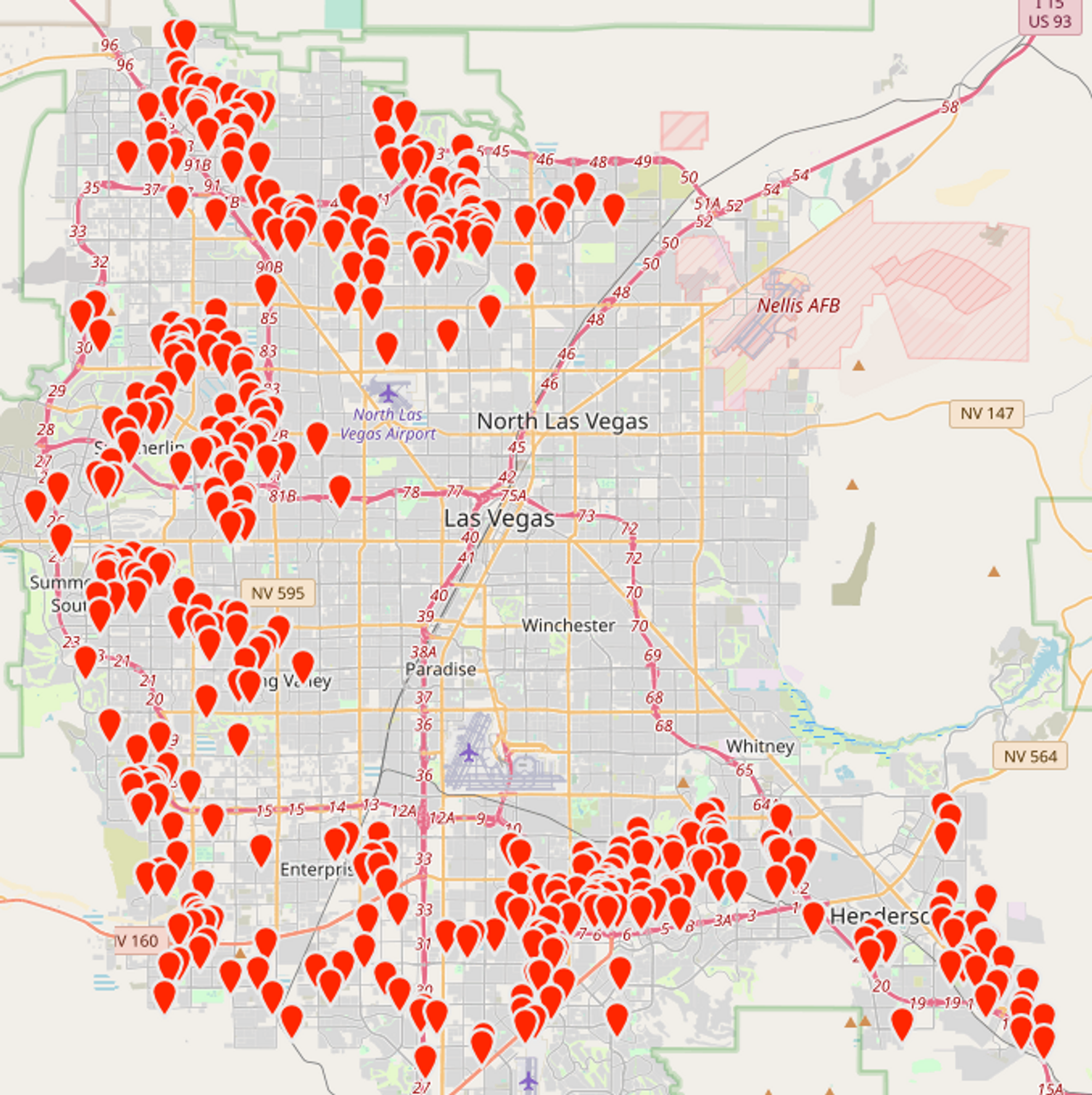 Prices
Prices
Sales - $/SqFt by Month
A December 2024 price decline and an unusual price spike in December 2023 (caused by lower interest rates) resulted in a 3.7% year-over-year growth. In November, the year-over-year growth was 7.6%, better representing the 2024 trend.

Sales - List to Contract Days by Month
The average days on the market stayed under 25 days, except for November and December, which are traditionally slow periods for the housing market.

Sales - Months of Supply by Month
Inventory remained between 1 and 2 months in 2024. A typical balanced market (where the number of buyers roughly equals the number of sellers) is about 6 months. This shows our segment of the market is a firm seller’s market.
 Rentals
Rentals
Rentals - $/SqFt by Month
A decrease in December from November puts the year-over-year increase at a modest 1.8%. However, November through January are typically the slowest rental periods.

Rentals - List to Contract Days by Month
The average days on the market for rentals remained under 30 days—except for December, traditionally the slowest rental month—indicating a robust rental market in our segment.

Rental - Months of Supply by Month
Rental inventory ranged between 0.9 months and 1.7 months. This low inventory will pressure up the rents.

Mortgage Interest Rate
In my 2024 Interest Rates Forecast, I stated that -
I expect 2024 to be a muddle-through year for interest rates, i.e. sticky (to where they are today) and will only move (up or down) if there are significant occasions. Even if they do move, I don't expect them to be significant based on what I can see now (no more than 1% changes in either direction).
It turned out to be what I expected. The 30-year fixed-rate mortgage rate started 2024 at around 6.6% and ended at 6.9%.
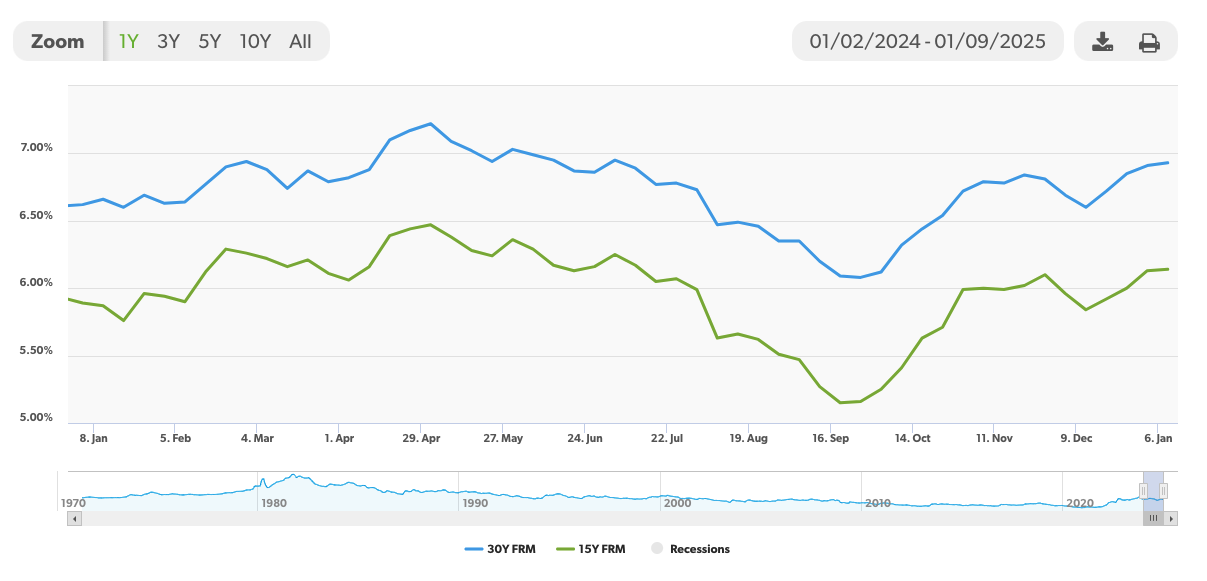
[Source: Freddie Mac]
Note that the high rates in April did not stop the price from rising, and the dip in September/October helped a price rebound that bucked the seasonal trend.
Looking Forward to 2025 and Beyond
Since the housing market is sensitive to interest rates, especially for our segment, I want to discuss my expectations for the mortgage interest rate first.
My 2025 Interest Rate ForecastThe Fed has started rate cuts in September 2024 but remains paused for now. This makes sense—with the economy performing well, there's no need to stimulate it through rate cuts that might reignite inflation. As a result, there are currently no clear drivers pushing interest rates lower.
Can the mortgage rates go further up?
The 30-year and 10-year Treasury yields rose around 18% in 2024. With the federal government running large budget deficits and its debt approaching dangerous levels, bond buyers demand higher interest rates to offset increased risks. Since mortgage rates are tied to long-term bond rates, any continued climb in bond rates will likely push mortgage rates higher as well. Given these factors, rates are more likely to rise than fall.
Of course, the Fed could stimulate the housing market by increasing its mortgage-backed securities (MBS) purchases, which would push mortgage rates down. However, there has been no indication that the Fed is considering this option. They are still winding down their tightening cycle, and as the saying goes—if it isn't broken, there's no need to fix it.
Overall, my forecast for mortgage rates in 2025 mirrors my 2024 predictions. Rates will likely remain in their current range between the low 6% and low 7%, though they could potentially climb into the mid-7% range.
Assuming that mortgage rates will remain mostly stable in 2025, let’s examine the Las Vegas real estate growth prospect.
Las Vegas Investment Real Estate 2025 OutlookUnlike complex financial markets, the housing market is relatively simple to analyze. Real estate prices and rents depend on just two key factors: supply and demand.
Supply
Supply for our segment (i.e., investment-grade Las Vegas real estate) has been in the 1-2 months range for 2024. This indicates more buyers than sellers, which is expected to increase prices.
The overall housing supply in Las Vegas has also been falling. The chart below shows the historical monthly inventory of single-family homes from 2014 to the present. The downward trend for the last ten years is apparent.
![[Source: Las Vegas Realtor Assocation MLS]](https://www.lasvegasrealestateinvestmentgroup.com/nwassets/images/MonthsOfSupplyByMonth20250116.png)
[Source: Las Vegas Realtor Association MLS]
Will/can the supply increase?
Not likely.
Given that mortgage rates are likely to stay at the current level (if not higher), existing homeowners have little motivation to move. Who would give up a sub-4% mortgage for a 7% mortgage unless you have to?
Can new homes come to the rescue?
Not in Las Vegas.
Las Vegas is a small island of private land surrounded by federal land. With minimal undeveloped private land left in the Las Vegas Valley and desirable areas costing over $1 million per acre, new homes in these locations start at $550,000. Since our target tenant segment seeks homes between $350,000 and $475,000, the supply of housing we target remains virtually unchanged regardless of new construction.
Demand
Can and will the demand for our target segment increase?
Likely.
The demand for housing is driven by population.
Las Vegas' population continues to increase at an average rate of about 2.3% per year and is projected to continue growing for the foreseeable future.
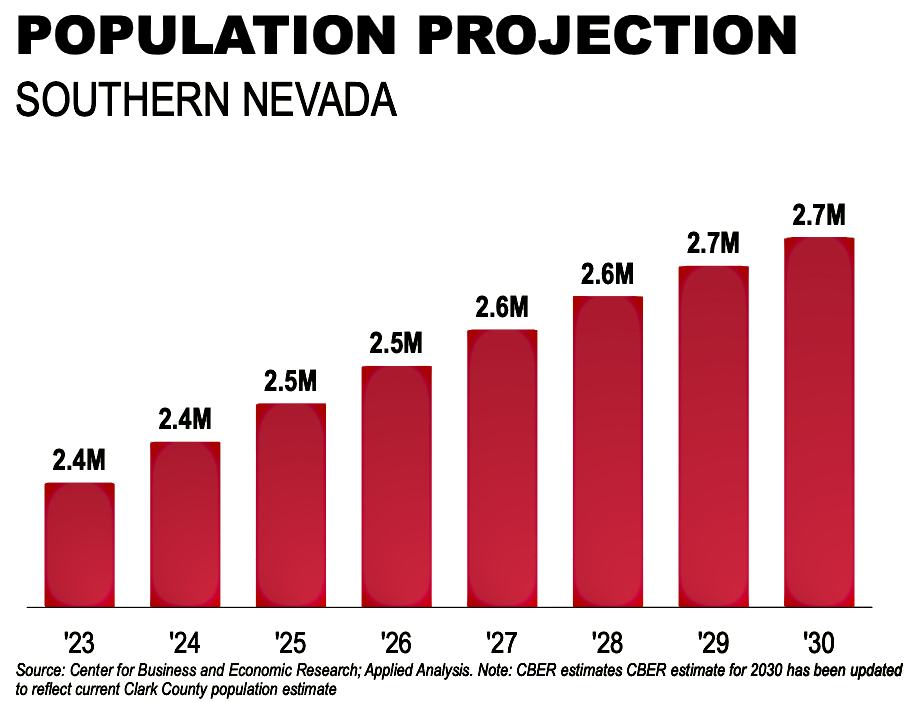
The factors that are attracting people to Las Vegas have not changed.
- Job growth - Businesses, large and small, continuously set up operations in Las Vegas. There are currently 28.3B worth of projects underway or planned. There will be worker shortages when you have this much investment going into a metro area of about 2.4M population. Jobs attract people.
- Lower cost - Lower cost of living, lower taxes, and lower cost of doing business continue to attract people and businesses from high-cost states such as California.
- Low crime: Las Vegas is Becoming the SAFEST City in America. This is part of why businesses and people are attracted to Las Vegas.
Another potential demand boost is the impact of Southern California fires. With over 10,000 homes destroyed plus an already existing housing shortage, the LA housing situation will become more undesirable. The destruction of business facilities also led to significant job losses, with many employers facing years of recovery—if they recover at all. We may see higher than usual relocation from LA to Las Vegas. Such migration would further increase demand pressure on our already limited housing supply.
When there is increasing demand and a stagnant (if not shrinking) supply, home prices and rents are bound to increase.
How fast will they increase is a much trickier question.
Although past performance doesn't guarantee future results, it remains our most reliable indicator. The following charts show the median price and rent per square foot for properties matching our target segment over the last 10 years, based on our analysis of MLS sales and rental data.
Appreciation:
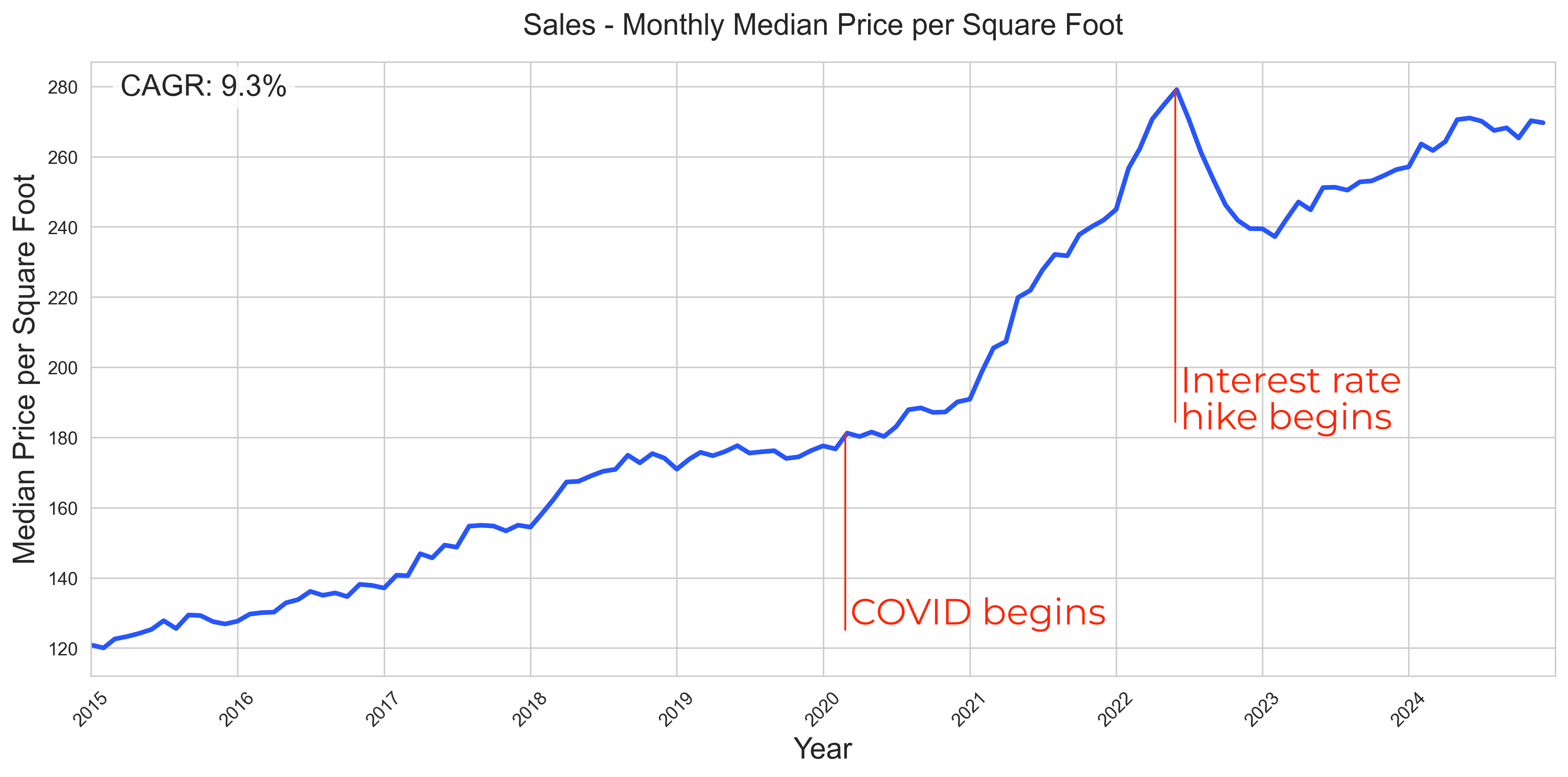
[Source: Fernwood Real Estate Investment Group]
Rent growth:
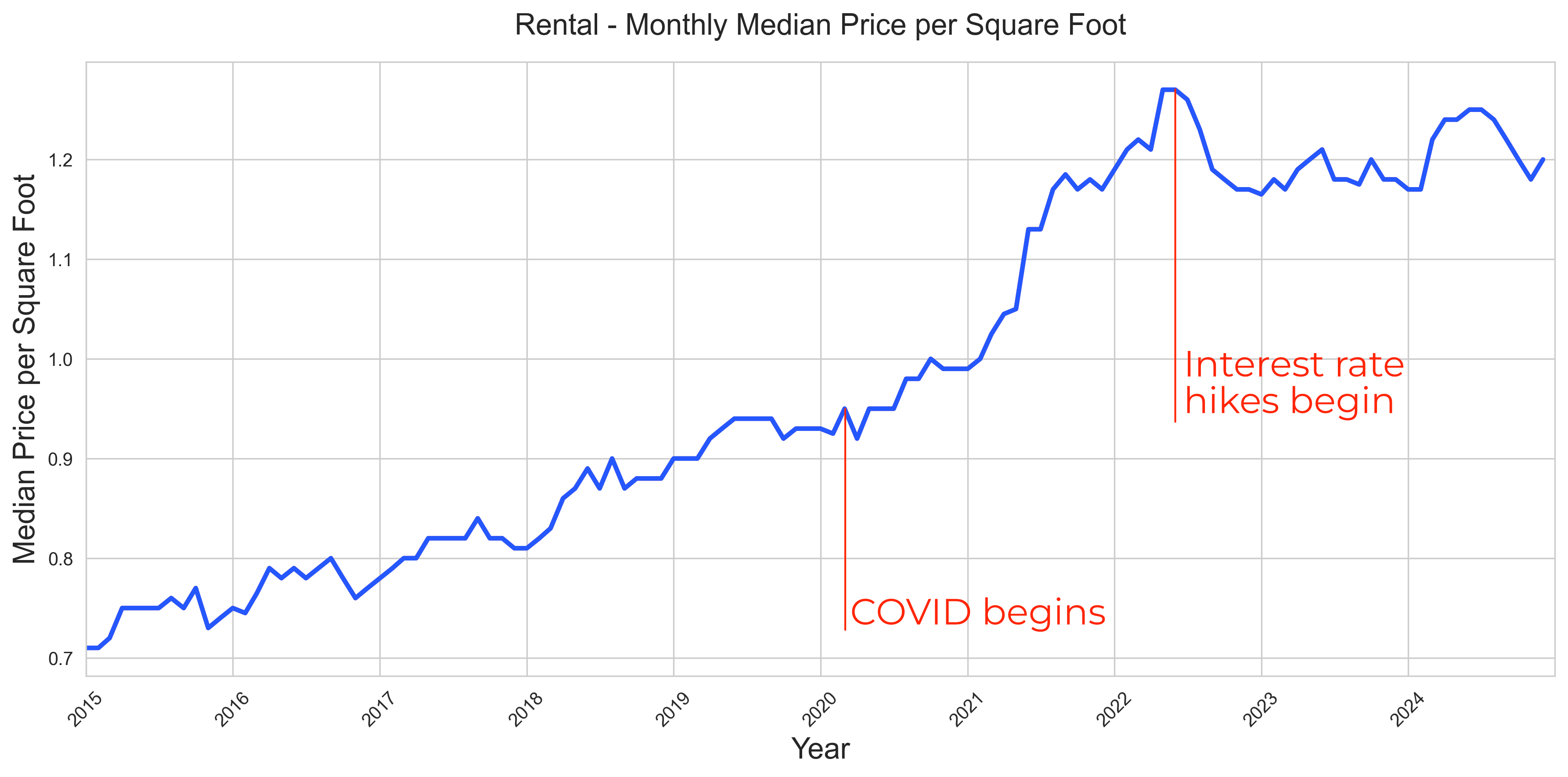
[Source: Fernwood Real Estate Investment Group]
As mentioned in my 2024 Outlook, the COVID market frenzy and the subsequent dramatic rate hikes significantly distorted price and rent trends. To better project growth rates for the next 5 years, we should examine the pre-COVID period from 2015-01-01 to 2020-03-01. The charts below show the median price and rent per square foot during this more stable period.
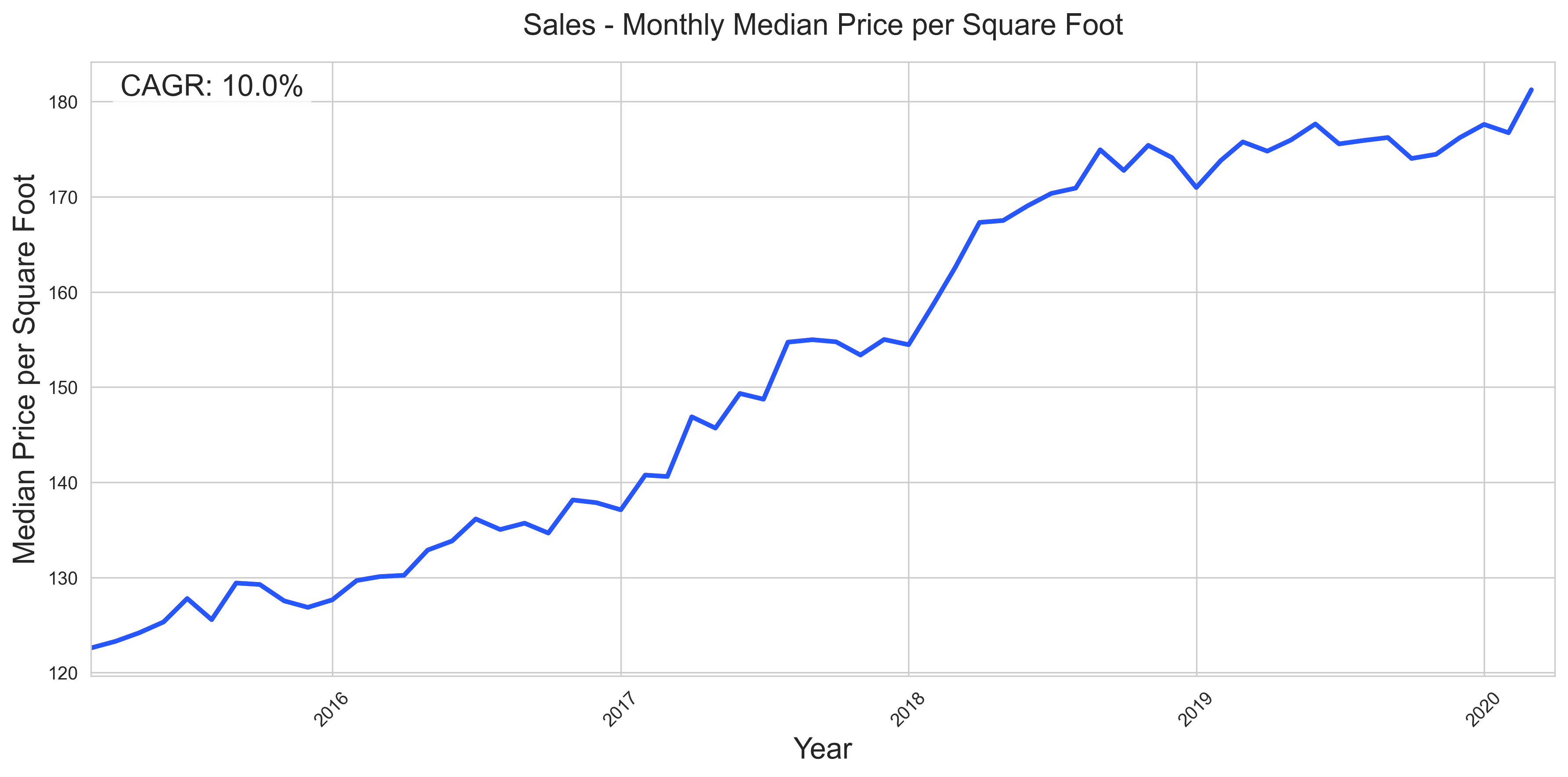
[Source: Fernwood Real Estate Investment Group]
Rent:
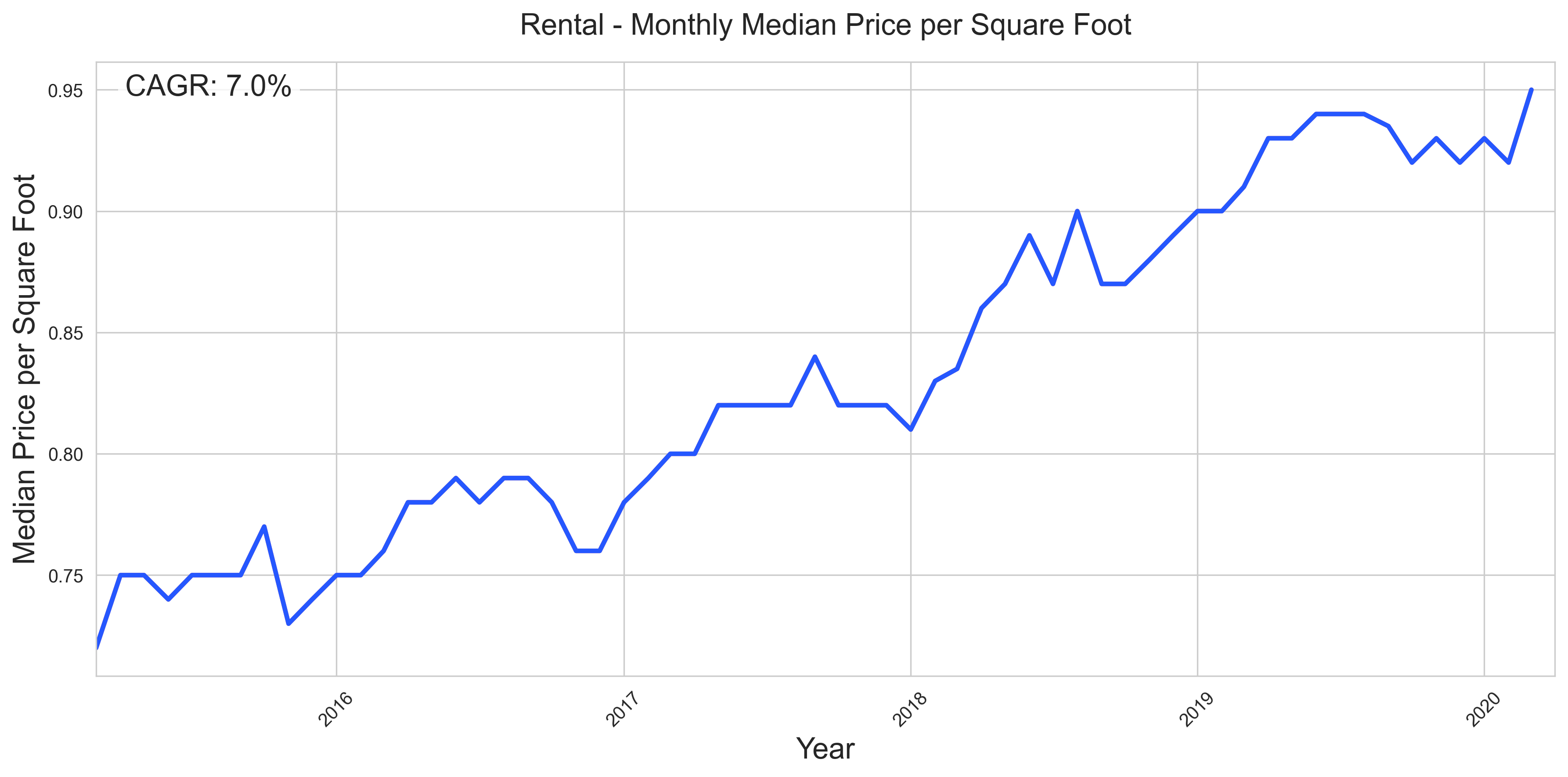
[Source: Fernwood Real Estate Investment Group]
Since the economic conditions today are similar (if not superior) to those in 2015, my expectations of the price and rent growth for the next 5 years align with the growth from 2015 to 2020. In other words, I expect the CAGR (Compounded Annual Growth Rate) for the prices for the next 5 years to be around 9-10% and the CAGR for the rents for the next 5 years around 7-8%
Of course, markets NEVER move linearly. Some years will see above-average growth, and others will see below-average growth.
Concluding Thoughts
A personal note:
Our goal is to provide you with the best information we can and be level-headed in our investor outlooks. Please let us know if you have corrections or recommendations.
Due to the continuing demand and chronically low supply (likely to get worse), we anticipate that prices and rent will continue to increase, even if interest rates do not fall. Further, we do not expect the interest rates to fall in 2025. So, if you have been considering investing in Las Vegas, waiting will not give you a “better” market condition (i.e., lower prices or lower interest rates) to enter. Rather, waiting will result in higher prices and loss of appreciation that could have been captured by acting now.
If interest rates do fall meaningfully in 2025—though this scenario is less likely—prices in our segment will increase rapidly as more buyers enter the market and compete for limited inventory. In this scenario, investors who act early rather than late will avoid missing out on this appreciation.
If you're interested in exploring how the current Las Vegas market conditions could align with your goals, please use the link below to schedule a time that works best for you.
 Post: Las Vegas Appreciation and Rent Growth Rate by Zip Codes
Post: Las Vegas Appreciation and Rent Growth Rate by Zip Codes
- Realtor
- Las Vegas, NV
- Posts 819
- Votes 1,572
Warning: This post contains many charts, and I did not see a way to simplify the presentation.
The zip codes in this study include: 89002, 89011, 89014, 89015, 89031, 89032, 89044, 89052, 89074, 89084, 89117, 89123, 89128, 89129, 89131, 89134, 89135, 89138, 89139, 89141, 89143, 89145, 89147, 89148, 89149, 89178, and 89183. See the map below for where these zip codes are located.
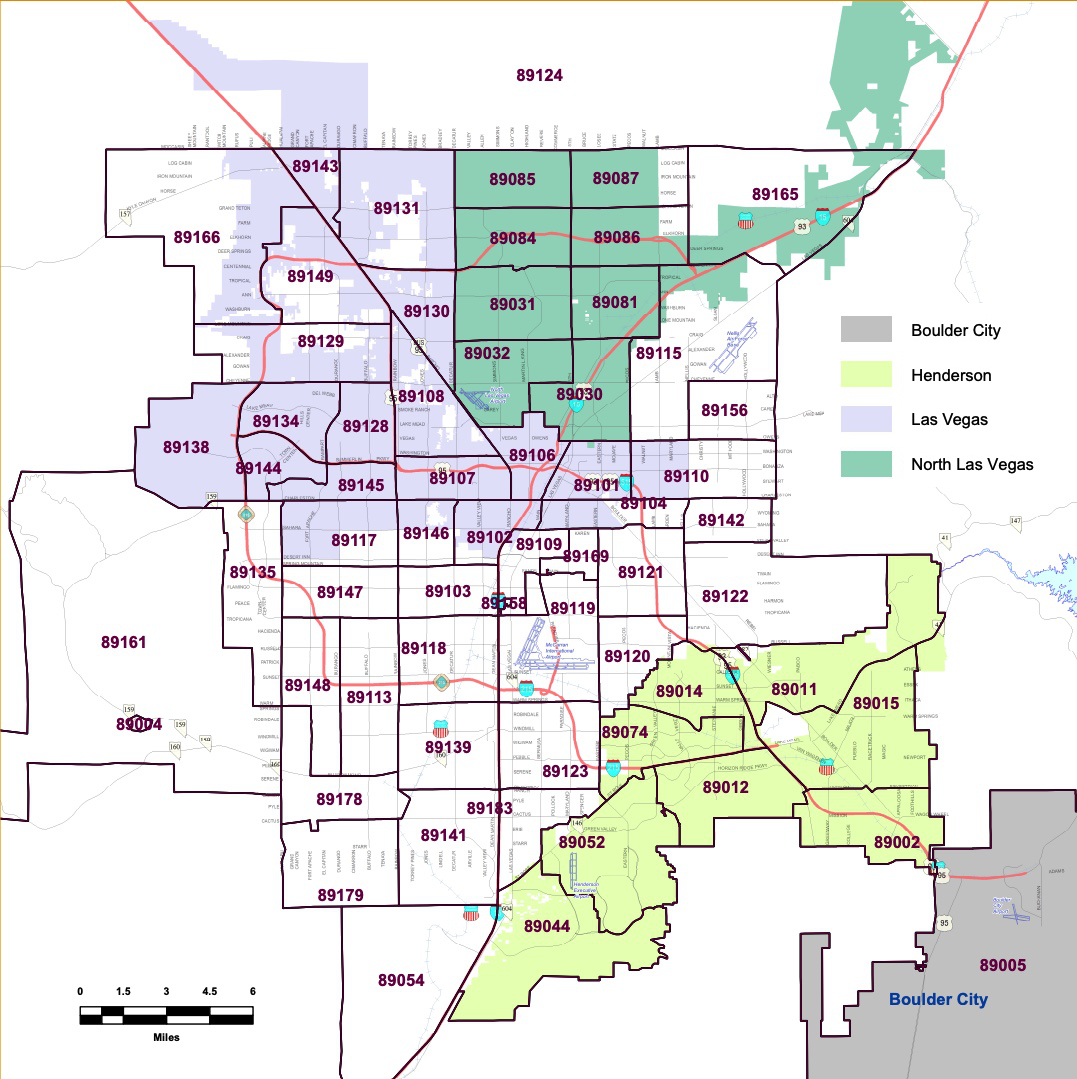
Note: The following charts only include properties in the above zip codes that generally match our property profile: single-family homes featuring 3-4 bedrooms, 2-3 bathrooms, 2-3 car garages, 1,100 to 2,400 square feet of living space, 1 or 2 stories, and lot sizes ranging from 3,000 to 6,000 square feet, built on or after 1985.
Appreciation
10-Year $/SF by Zip Code 2015-01-01 to 2024-12-31
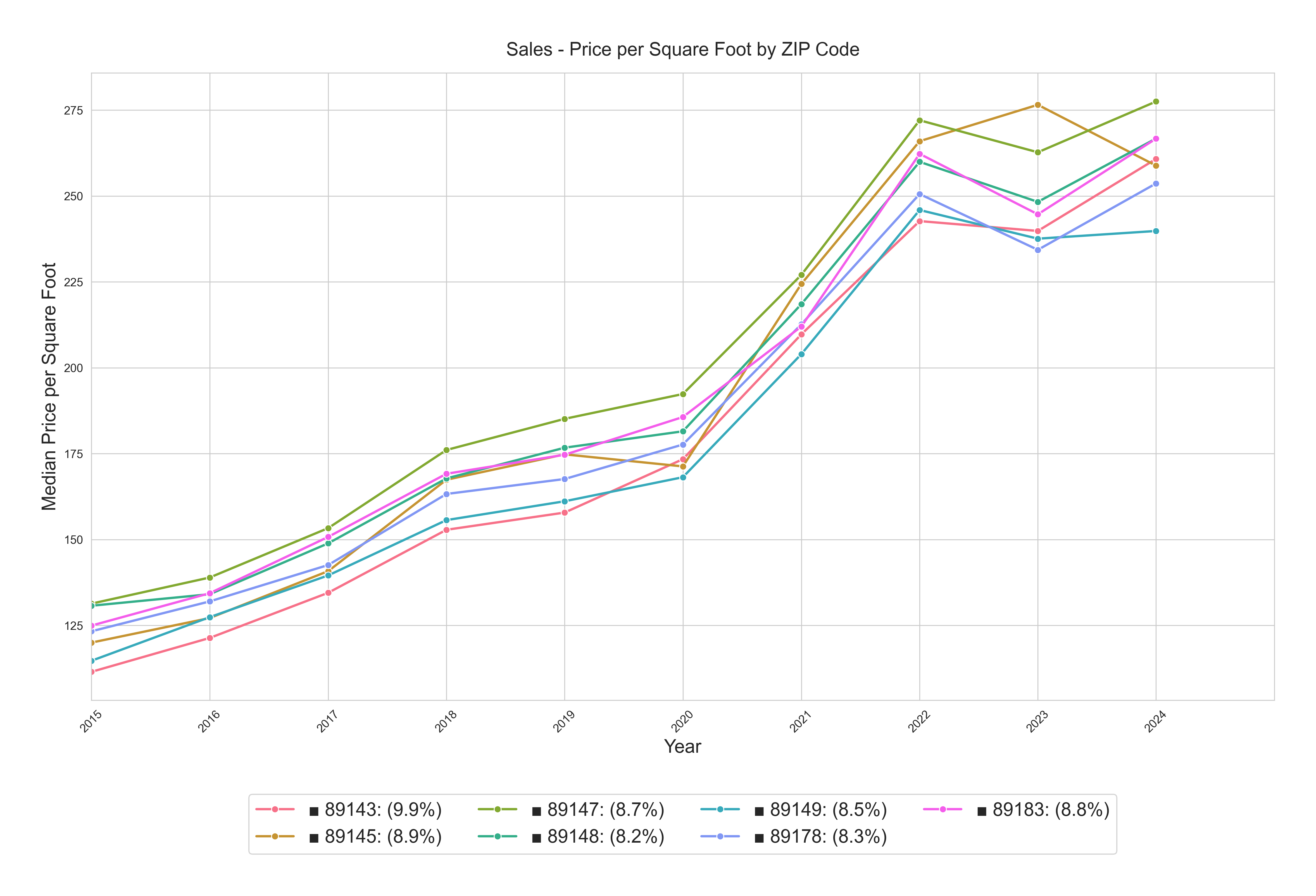
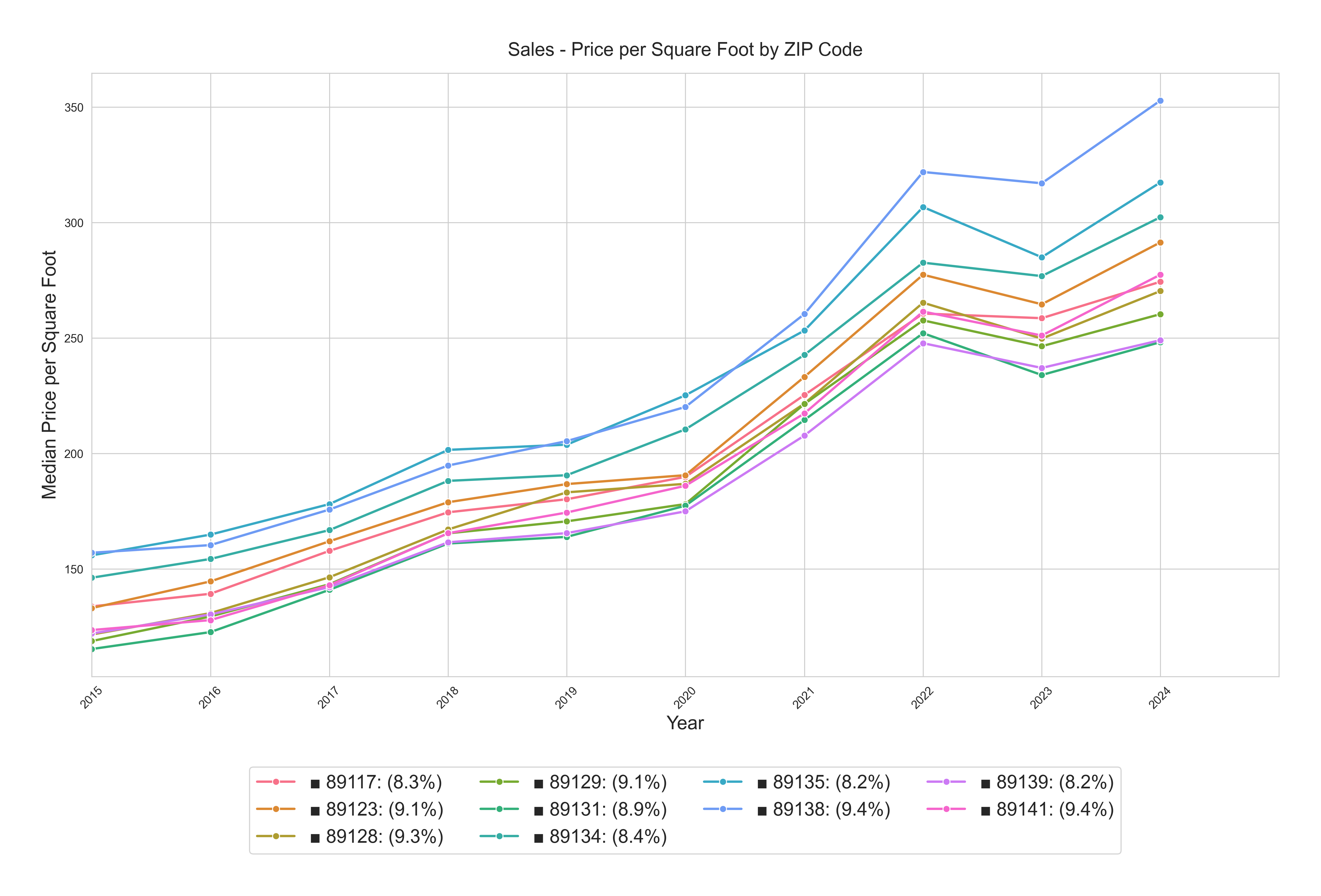
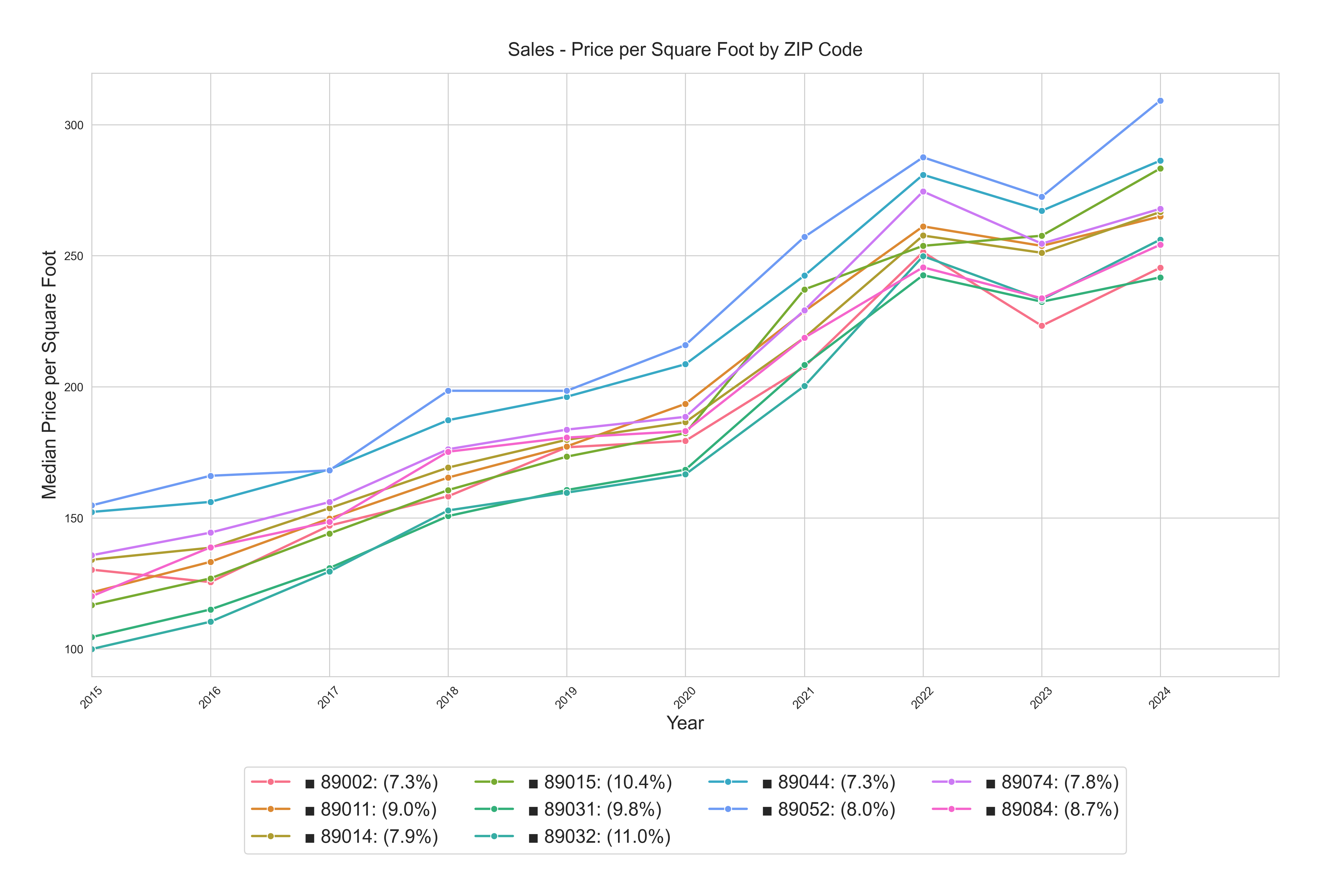
From the above charts, these zip codes appear to appreciate the fastest among our target areas (based on annualized growth rate)
- 89032 (North Las Vegas), 11.0%
- 89015 (Henderson), 10.4%
- 89143 (Centennial Hills), 9.9%
- 89031 (North Las Vegas), 9.8%
- 89138 (Summerlin), 9.4%
- 89141 (Blue Diamond, Southern Highlands), 9.4%
- 89128 (Summerlin), 9.3%
- 89123 (Silverado Ranch), 9.1%
- 89129 (Northwest), 9.1%
5-Year Pre-COVID $/SF by Zip Code 2015-01-01 to 2020-03-01
The COVID market frenzy and the subsequent dramatic rate hikes significantly distorted price and rent trends. To better project growth rates for the next five years, we should examine the pre-COVID period from 2015-01-01 to 2020-03-01. The charts below show the median price trend during this more stable period.
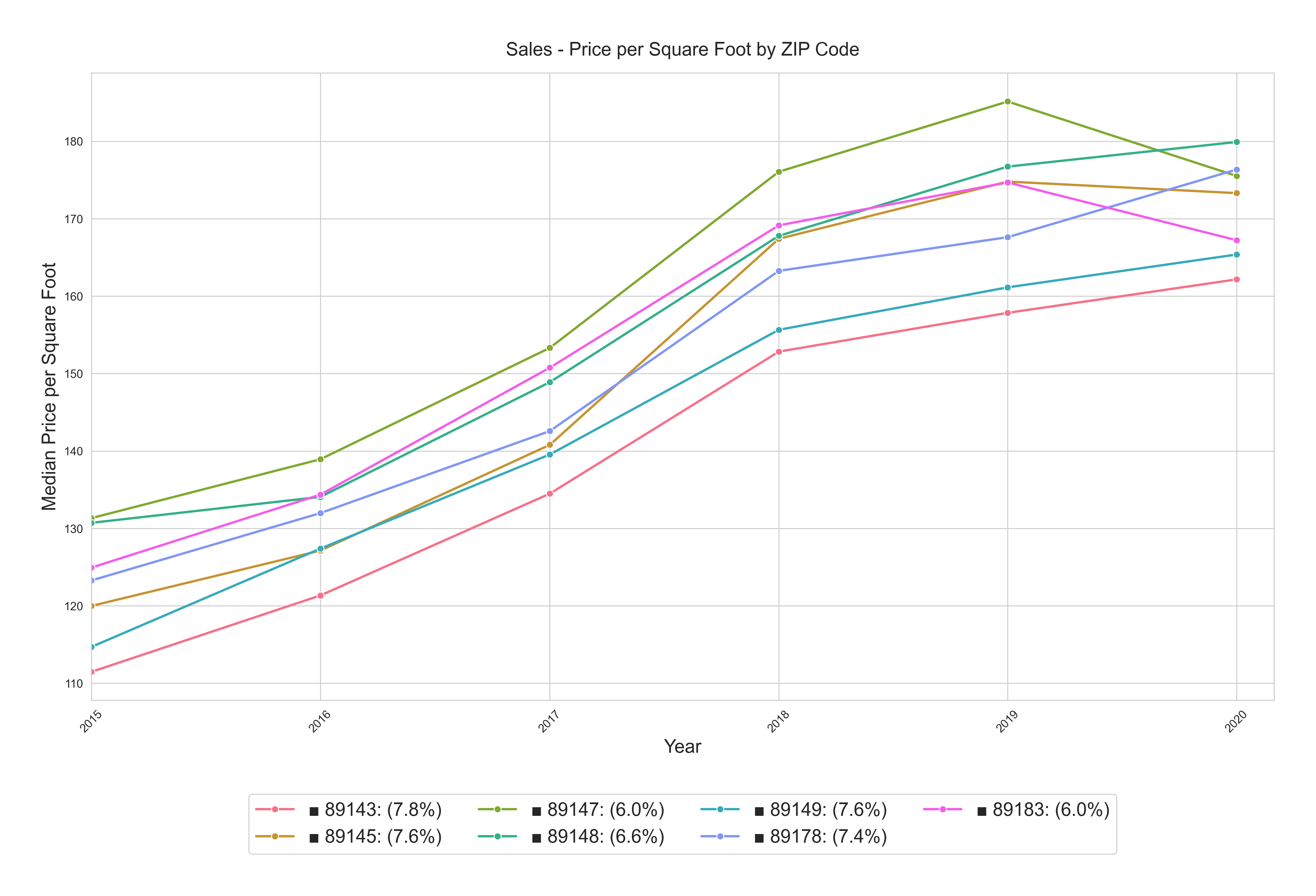
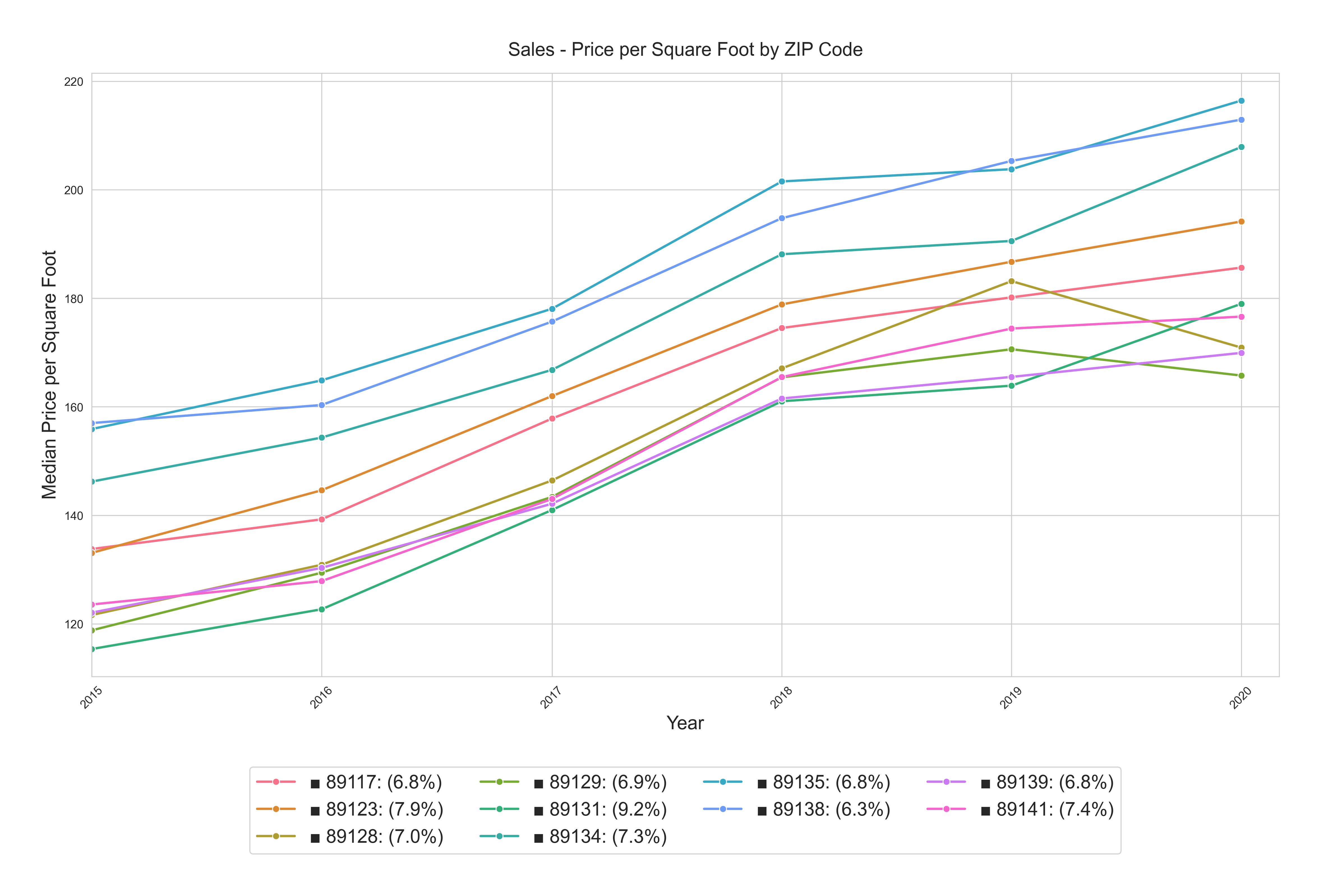

The higher appreciating zip codes during the 5-year pre-Covid period appear to be:
- 89032 (North Las Vegas), 10.2%
- 89015 (Henderson), 9.7%
- 89131 (Centennial Hills), 9.2%
- 89031 (North Las Vegas), 9.2%
- 89084 (Aliante), 8.5%
- 89011 (Henderson), 8.1%
- 89123 (Silverado Ranch), 7.9%
- 89141 (Blue Diamond, Southern Highlands), 7.4%
- 89134 (Summerlin), 7.3%
Rent Growth
10-Year Rents $/SF by Zip Code 2015-01-01 to 2024-12-31
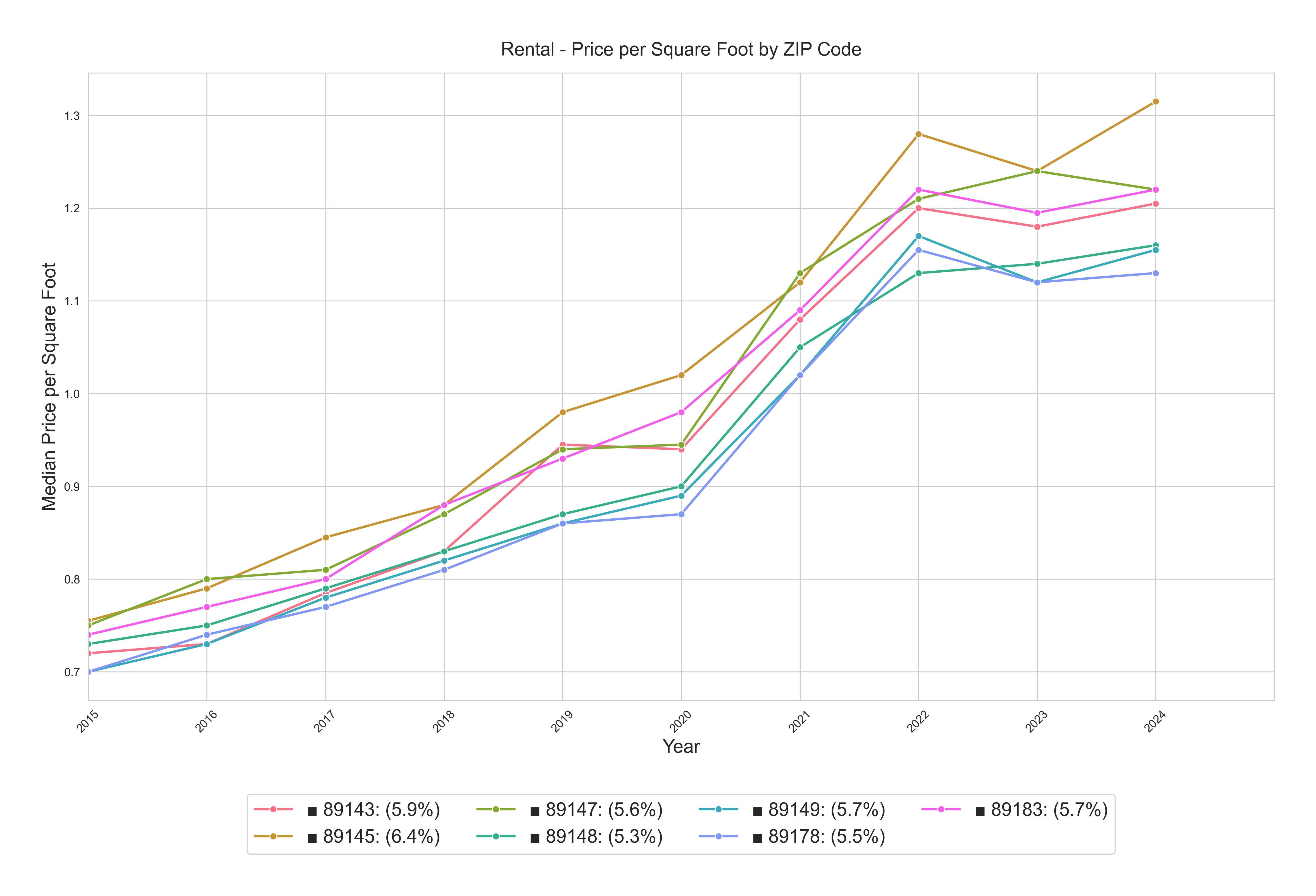
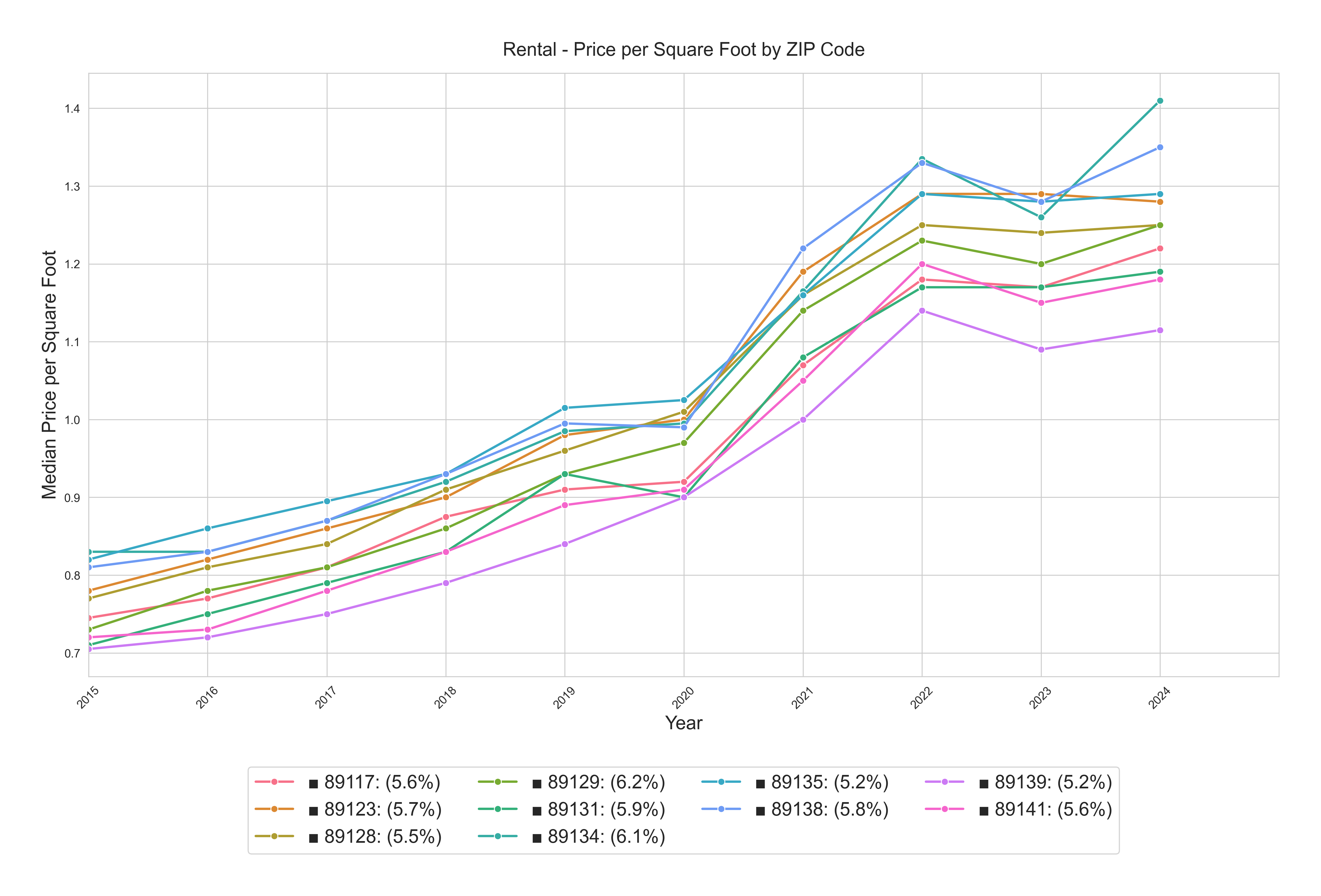
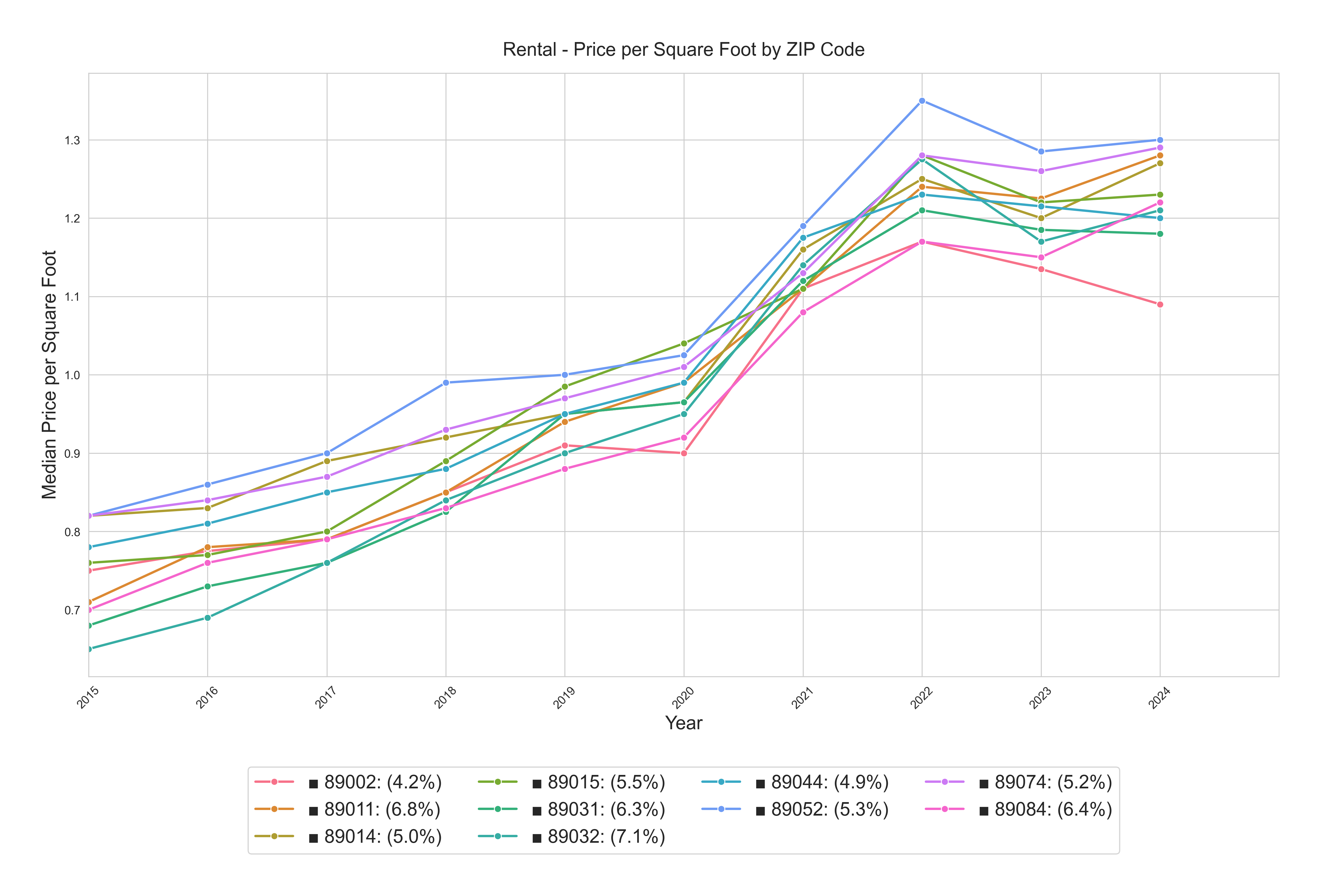
The higher rent growth zip codes for the last 10 years appear to be:
- 89032 (North Las Vegas), 7.1%
- 89011 (Henderson), 6.8%
- 89084 (Aliante), 6.4%
- 89145 (Summerlin adjacent), 6.4%
- 89031 (North Las Vegas), 6.3%
- 89134 (Summerlin), 6.1%
5-Year Pre-Covid Rents Trend $/SF by Zip Code 2015-01-01 to 2020-03-01
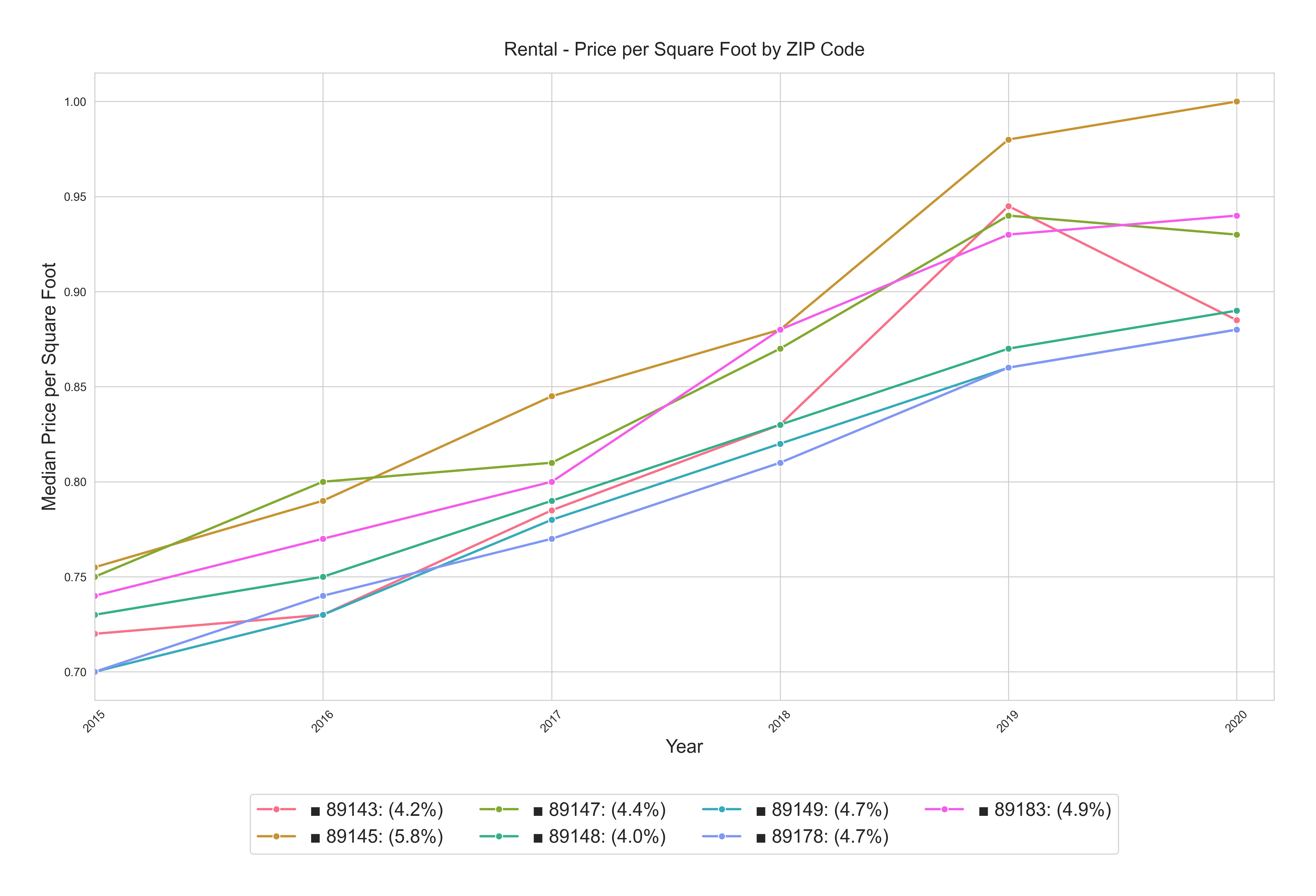
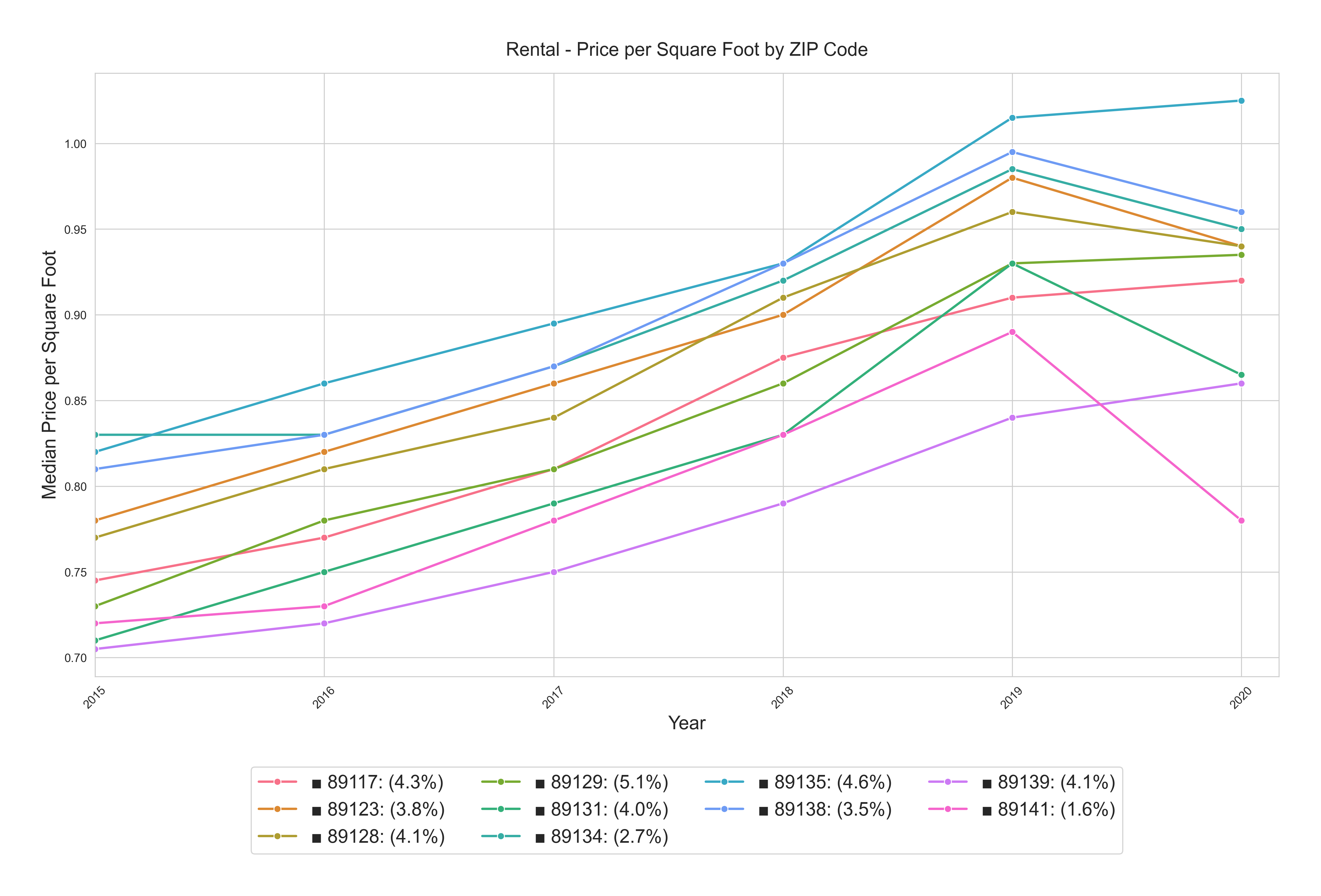
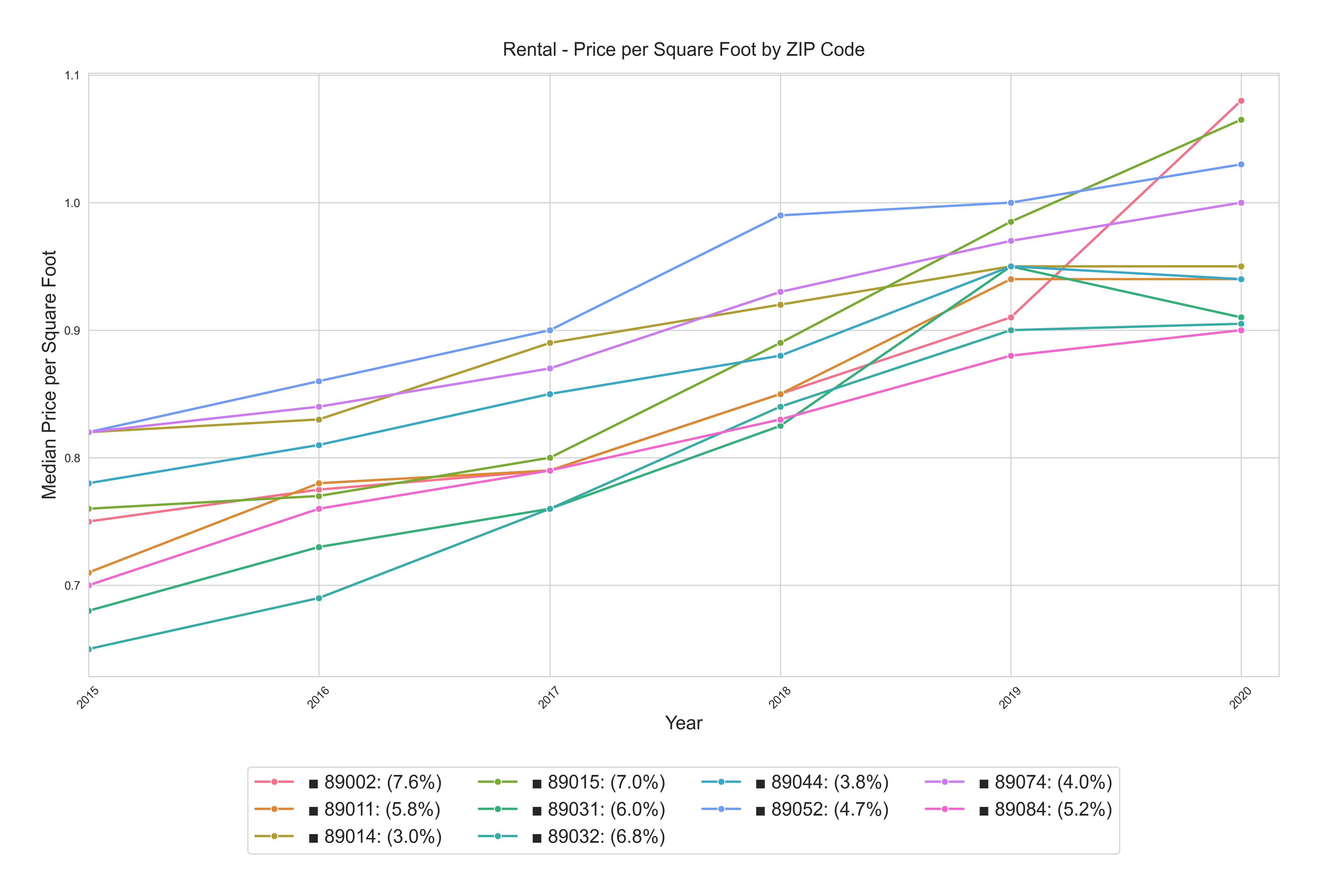
The faster rent growth zip codes during the 5-year pre-Covid period appear to be:
- 89002 (Henderson), 7.6%
- 89015 (Henderson), 7.0%
- 89032 (North Las Vegas), 6.8%
- 89031 (North Las Vegas), 6.0%
- 89011 (Henderson), 5.8%
- 89145 (Summerlin adjacent), 5.8%
Concluding Thoughts
If past performance is any indication of future performance, the data shows that properties in certain parts of North Las Vegas, Henderson, Centennial Hills, Silverado Ranch, and certain Summerlin areas may appreciate faster than the other areas of our target area. Properties in Henderson, certain parts of North Las Vegas, and adjacent to Summerlin may provide faster rent growth.
However, we recommend not using this data for your property search criteria. A zip code average of an area does not represent an individual property’s characteristics. Each property should be evaluated based on its characteristics and overall quality as an investment.
 Post: From a finance perspective, how does investing in a high rate environment work?
Post: From a finance perspective, how does investing in a high rate environment work?
- Realtor
- Las Vegas, NV
- Posts 819
- Votes 1,572
Hello @Alex Silang,
It depends on your goal. If your goal is day-one cash flow, the current high interest rates will make it very difficult. If your goal is financial freedom, which is a long-term goal, not so much.
Financial freedom is a long-term proposition, not a one-time event. Financial freedom isn't simply about replacing your current income, because inflation continuously drives up prices, making a fixed income insufficient to maintain your standard of living. You need an income that meets three requirements:
- Rents increase faster than inflation to offset constantly rising prices.
- It must be reliable; it continues even during economic downturns.
- It must last throughout your lifetime.
These are all long-term requirements, so the current interest rates are not the major issue. Interest rates will eventually come down. When they do, you can refinance to a lower rate.
Dealing with current high interest rates (about 7% on 01/27/2025) you have the following choices:
- A larger down payment
- Accept a negative cash flow
- Buy down the interest rate
Combine and balance all three to get an acceptable cash flow today. However, what is far more important for financial freedom is the location/city where you invest.
The city where you invest is far more important than the current interest rate. The city determines whether your investment can meet the three requirements mentioned above. What happens if you invest in a city where rents don't keep up with inflation?
For instance, let's say you purchase property in a city where rents rise by 2% per year, while inflation is at 5% per year. Your starting rent is $2,000 per month, and your expenses remain steady at $1,700 per month. What would your inflation-adjusted monthly income be in 5, 10, and 15 years?
- Year 0: ($2,000 - $1,700) x (1 + 2%)^0 / (1 + 5%)^0 ≈ $300 in today’s buying power.
- Year 5: ($2,000 - $1,700) x (1 + 2%)^5 / (1 + 5%)^5 ≈ $260 in today’s buying power.
- Year 10: ($2,000 - $1,700) x (1 + 2%)^10 / (1 + 5%)^10 ≈ $225 in today’s buying power.
- Year 15: ($2,000 - $1,700) x (1 + 2%)^15 / (1 + 5%)^15 ≈ $194 in today’s buying power.
So, if you purchase property in a city where rent increases at a slower pace than inflation, the amount of goods and services you can buy will decrease over time due to inflation.
Here is what I recommend:
- Purchase in a city that possesses the following characteristics.
- Significant and sustained population growth.
- Rapid and sustained appreciation
- Balance negative cash flow, interest rate buydown, and increased down payment to create an acceptable cash flow situation today.
- Refinance when rates fall to increase cash flow.
 Post: How to self-manage out-of-state property
Post: How to self-manage out-of-state property
- Realtor
- Las Vegas, NV
- Posts 819
- Votes 1,572
Hello @Yooni Choi,
While managing an out-of-state rental property yourself might seem like a money-saving strategy, the reality is much more complex. Drawing from my experience delivering over 550 investment properties, I can say with certainty that self-management isn't practical for most investors. In fact, even with my extensive experience, I choose to have all my properties professionally managed.
Here's why:
Tenant Selection Is Critical
The most valuable service a property manager provides is selecting reliable tenants. The wrong tenant can lead to non-payment, evictions, and property damage. Finding someone with the expertise to screen and place tenants properly is rare. Personally, after working with numerous property managers in Las Vegas, I only trust two to handle this task for my properties.
Compliance Is Complicated
Property management involves navigating a maze of city, state, and federal regulations. Professional property managers stay updated on legal requirements through memberships in state or national organizations. Unless you're monitoring these regulations full-time, it's easy to make costly mistakes. Even a single error could cost you more than years of property management fees.
Understanding Tenant Behavior
Properties don’t pay rent—tenants do. A skilled property manager understands tenant segments and their behaviors, which helps attract reliable renters. They can also guide you in choosing properties that appeal to dependable tenant demographics.
Access to Reliable Vendors
Property managers have established networks of cost-effective contractors for renovations and repairs. Without these connections, you’re likely to spend more time and money finding reliable help.
Enforcing Lease Terms
Proactively managing tenants and enforcing lease terms reduces the risk of evictions and other issues. This requires consistent oversight and experience, which most investors simply don’t have.
The Bottom Line
If you want to lose money and risk expensive legal fees, go ahead and self-manage. Otherwise, leave it to the professionals who have the experience, systems, and resources to do it right.




